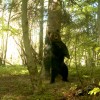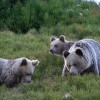The brown bear is a hunted species throughout its range in Sweden and in areas removed from the female core areas in Norway. The Swedish policy is to maintain the population above 1100-1400 individuals, which is the basis level for a favorable conservation status. Although this is the national minimum population goal (there is no maximum population goal), most of the management of brown bears has been delegated to the county level of administration. The goal for brown bears in Norway is expressed in annual reproductions. The national goal (an exact goal, i.e., both maximum and minimum level) is 13 annual reproductions, which translates to about 127 bears. In 2013, the estimated number of reproductions was 7, with reproductions recorded in 3 of the 4 large carnivore administrative regions with reproduction goals for brown bears.

Brown bear populations are estimated using DNA extracted from scats and hair collected by cooperating hunters in Sweden and primarily by state employees in Norway. These collections occur in each county about every 5-10 years in Sweden and every year throughout the country in Norway. In addition, population trends in Sweden are monitored by observations made by moose hunters, which are corrected for the number of hours afield. Norway and Sweden are cooperating on a common monitoring system and common database for management-relevant data about brown bears.
Brown bear den in northern forest (photo by Filip Zięba)





















